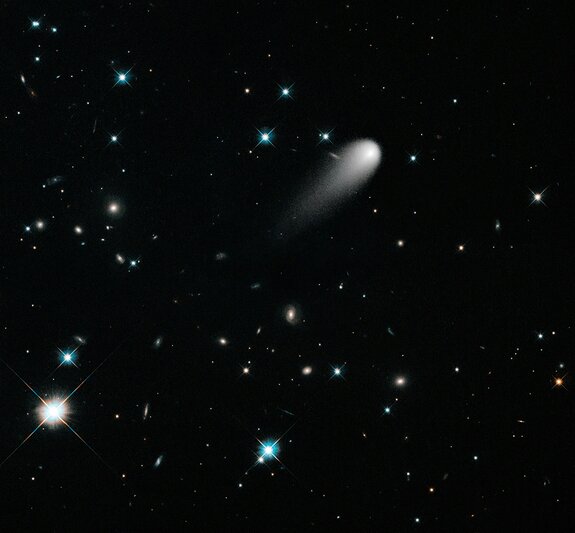After several weeks of being hidden behind the Sun, comet C/2012 S1 (ISON) finally emerged from solar conjunction mid August, and early, tentative measures of its brightness by CIOC hint that it is beginning to slowly brighten up.CIOC writes: From the ground, we last saw Comet ISON in June of this year, and at the time there was much concern that it had brightened only marginally since January. So when we lost sight of it behind the Sun, speculation began to circulate that maybe ISON really was a dud. Indeed some rather alarmist reports even claimed that the comet had already fizzled!
So as the weeks pressed on through July and into August, we waited impatiently for the comet to reappear from behind the Sun, holding our breath and wondering when the first observers would capture it.
Comet C/2012 S1 (ISON) orbit diagram on August 26, 2013. Image credit: NASA/JPL
Mars fly by – crossing the “frost line”
At about 17:24 UTC on October 1, 2013, Comet ISON will fly by Mars within 0.07 AU, which is about six times closer than it will ever come to Earth. (1 AU = One Astronomical Unit, or the mean distance between the Sun and the Earth)The Mars flyby comes at a key time in Comet ISON’s journey. It will have just crossed the “frost line,” a place just outside the orbit of Mars where solar heating is enough to start vaporizing frozen water.”The volatiles in a comet are 80% to 90% water ice,” notes astronomer Carey Lisse of the Johns Hopkins University Applied Physics Lab. “Right now in August almost all the water is still frozen, and the outgassing we see in ISON is driven by carbon dioxide and other lesser constituents. Probably only isolated patches of the comet’s nucleus are active.
“Comet C/2012 S1 (ISON) orbit diagram on October 1, 2013 – Mars Fly By.
Image credit: NASA/JPLBut when ISON crosses the frost line, “the whole comet could erupt in geysers of gas,” says Lisse. “Mars orbiters will have a ringside seat.”The amount of outgassing at Mars will give researchers clues to the size of ISON’s nucleus, which is hidden from view deep within the comet’s dusty atmosphere.”If ISON’s nucleus is much bigger than 0.5 km, it will probably survive its Thanksgiving Day brush with the sun,” says Lisse. “It could turn into one of the most spectacular comets in many years.”
Meeting the Sun and close approach to Earth
On November 28, 2013 ISON will experience a close encounter with the Sun at a distance of 0.012AU – only around 3 solar radii, which is extremely close to the Sun, and small enough of a distance to qualify it as a sungrazing comet.
Also there is another interesting thing happening at that time with our mother star (Sun):
[youtube=http://www.youtube.com/watch?v=34gNgaME86Y&w=560&h=315]Remember the sun diving comet from 20th of August and wath had happened then:
[youtube=http://www.youtube.com/watch?v=hr2v9aoWy3I&w=420&h=315]Is this just a coincidence or something that we should be worried about.
NASA says “Just a Coincidence” is it ?
Watch this interesting documentary :
[youtube=http://www.youtube.com/watch?v=34wtt2EUToo&w=560&h=315]Source: The Watchers, NASA
TBU NEWS







